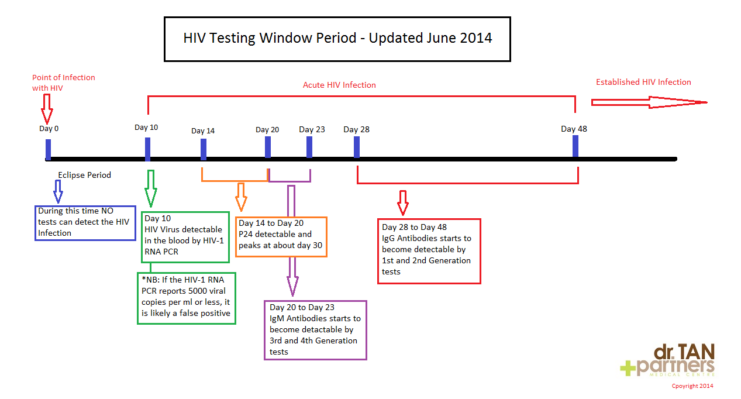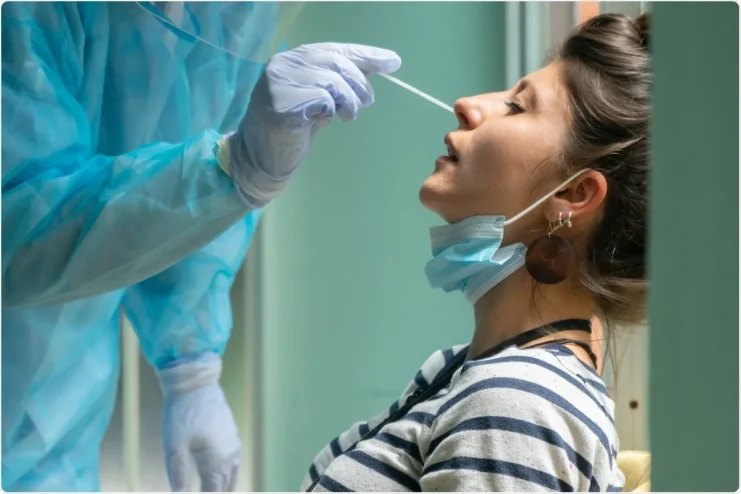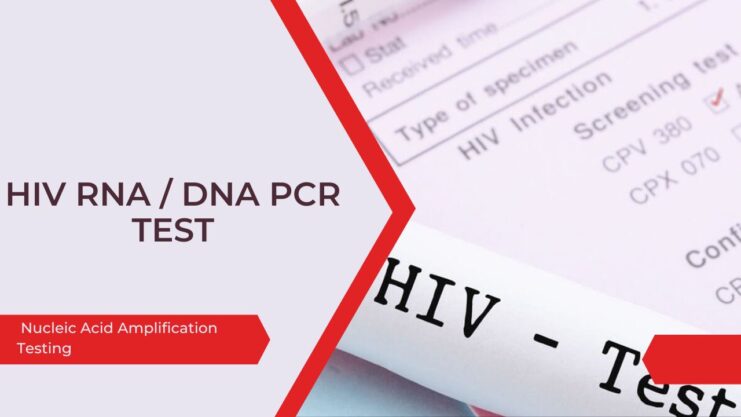Human Immunodeficiency Virus (HIV) continues to be a significant global public health issue. As of the last few decades, substantial progress has been made in the field of HIV diagnosis and treatment, leading to improved patient outcomes and increased life expectancy for those living with the disease. However, early detection remains a crucial factor in effectively managing HIV and preventing its progression to Acquired Immunodeficiency Syndrome (AIDS).
Among the various diagnostic tests available, the HIV RNA/DNA PCR Test, also known as Nucleic Acid Amplification Testing (NAAT), plays a vital role in detecting the presence of the virus at the earliest stages of infection. It offers a ray of hope for individuals potentially exposed to HIV, allowing for swift therapeutic intervention and improved disease management.
This article aims to provide a comprehensive understanding of the HIV RNA/DNA PCR Test or NAAT. Here, we delve into the science behind the test, its methodology, interpretation of results, and its significance in HIV diagnosis and management.
The HIV RNA test is deemed to be 100% conclusive if done after 10 to 12 days from the date of exposure.

There are some theories that say this test becomes less accurate from about 3 months post-exposure. This is because at 3 months post-exposure, the body would have made antibodies to fight the HIV virus. Therefore, the amount of virus in the blood may drop below the detection limit of the RNA test.
Acute HIV infection is very challenging to identify because its symptoms are not specific and antibody tests often are either still negative or indeterminate. However, this is also the time when an infected person is most contagious due to a high viral load.
Detection of acute HIV infection not only enables us to counsel the patient on taking active steps to reduce transmission, it also enables us to better identify potentially infected partners as the time span we need to focus on is still relatively short.
Currently, the vast majority of HIV tests are conducted using antibody tests. These include rapid tests such as Oraquick™ (Rockeby) and Determine™ (Abbott) and also conventional blood ELISA tests.
Limitations of Antibody Tests in Detecting HIV
HIV antibody tests have been the mainstay of HIV diagnostics for many years. These tests work by detecting antibodies produced by the body’s immune system in response to an HIV infection. However, this method has some notable limitations.
The main challenge with antibody tests is the ‘window period’—the time between potential exposure to HIV and the point when the test will give an accurate result. For most people, antibodies to HIV will develop within two to eight weeks of exposure. Some people may take longer to produce antibodies, and in rare cases, it can take up to three months. During this window period, an individual could receive a negative test result despite being infected, leading to false reassurance and potentially increased transmission if safe practices are not followed.
Furthermore, because these tests rely on the body’s immune response, they may not be as effective in people with certain conditions that affect the immune system.
Acute HIV Infection: Symptoms and Risks
Acute HIV infection, also known as primary HIV infection, refers to the initial stage following exposure to the virus, typically within the first two to four weeks. This phase is characterized by a rapid increase in HIV replication and the spread of the virus throughout the body.
Symptoms of acute HIV infection can be non-specific and easily mistaken for other illnesses like the flu. They may include fever, fatigue, sore throat, swollen glands, rash, muscle and joint pain, and headache. However, some people may not experience any symptoms at all.
Acute HIV infection presents significant risks due to the high levels of the virus in the body, making individuals more likely to transmit HIV to others. Moreover, because antibody tests often yield negative or indeterminate results during this phase, acute HIV infection can be difficult to diagnose, further increasing the risk of unknowingly transmitting the virus.
NAAT tests for HIV require only 10 days post-exposure to be accurate. It is the only option for detecting HIV infection before seroconversion.
Benefits of NAAT include

- Earlier identification of infected persons leads to reduced transmission risks
- Facilitate partner identification, counseling and testing
- Early diagnosis leads to early initiation of follow-up and treatment leading to a better prognosis
However, NAAT increases the cost and turnover time for HIV testing.
A screening program for Acute HIV Infection using pooled NAAT was successfully conducted by the New York City Department of Health and Mental Hygiene. Specimens from all patients whose rapid HIV antibody test was negative were tested by a polymerase chain reaction in pools of 512 specimens.
If the pool was positive, component specimens were tested to identify which specimen(s) contained HIV RNA. The report findings confirmed that pooled NAAT can increase Acute HIV Infection diagnoses among high-risk STD patients. It can also be used to identify areas or populations in which HIV infection is spreading.
The usual turnaround time is 2 weeks.
However, the Lab can conduct an expedited test for a surcharge.
Preparing for Test: What to Expect

Undergoing the HIV RNA/DNA PCR test does not require any specific preparation, such as fasting. You can continue with your normal diet and routine before the test.
The test itself is simple and involves a standard blood draw. A healthcare professional will clean an area of your arm before inserting a needle to collect a blood sample, which will then be sent to a lab for analysis.
The usual turnaround time for results is approximately two weeks, but expedited testing options may be available for an additional fee. During this waiting period, it’s important to continue practicing safe behaviors to prevent potential transmission of HIV or exposure to other sexually transmitted infections.
Once the results are available, they will be reviewed by a healthcare professional who can explain what they mean and discuss the next steps. If the test detects HIV, you will be guided through the options for treatment and management to help control the virus and maintain your health. If the test is negative, it’s still important to regularly get tested if you’re at risk and continue to engage in safe practices.
FAQ
Are there any special preparations required before taking the HIV RNA/DNA PCR Test?
No, there are no specific preparations needed before taking the HIV RNA/DNA PCR Test. You do not need to fast or alter your normal diet and routine before the test.
Is the HIV RNA/DNA PCR Test used in screening programs?
Yes, the HIV RNA/DNA PCR Test has been successfully used in screening programs for acute HIV infection. For example, the New York City Department of Health and Mental Hygiene conducted a program using pooled NAAT. Specimens from all patients whose rapid HIV antibody test was negative were tested in pools by a polymerase chain reaction. This program confirmed that pooled NAAT can increase acute HIV infection diagnoses among high-risk STD patients and help identify areas or populations in which HIV infection is spreading.
How does the HIV RNA/DNA PCR Test compare to other tests in terms of cost and turnover time?
While the HIV RNA/DNA PCR Test offers significant advantages in terms of early detection, it tends to be more expensive and have a longer turnover time compared to other HIV tests. The usual turnaround time for results is approximately two weeks, but expedited testing options may be available for an additional fee. However, the benefits of early detection and the potential for reducing HIV transmission make it a valuable tool in HIV diagnosis and management.
What is the ‘window period’ in HIV testing?
The ‘window period’ in HIV testing refers to the time between potential exposure to HIV and the point when a test will give an accurate result. For most people, antibodies to HIV will develop within two to eight weeks of exposure. Some people may take longer to produce antibodies, and in rare cases, it can take up to three months. During this window period, an individual could receive a negative test result despite being infected.
Can the HIV RNA/DNA PCR Test detect HIV sooner than other tests?
Yes, the HIV RNA/DNA PCR Test, or NAAT, can detect HIV sooner than other tests. It can accurately detect HIV infection as early as 10 days post-exposure before the body has had time to produce detectable levels of antibodies. This is a significant advantage, as it allows for earlier intervention and management of the disease, reducing the risk of transmission.
Conclusion
The HIV RNA/DNA PCR Test or Nucleic Acid Amplification Testing (NAAT) is a crucial tool in the early detection and management of HIV. Its ability to identify the virus as early as 10 days post-exposure allows for swift therapeutic intervention and improved disease control. While it does carry a higher cost and longer turnover time compared to other HIV tests, the potential benefits it offers in terms of reducing HIV transmission and improving patient outcomes are significant. As we continue to combat HIV on a global scale, the importance of early and accurate detection cannot be overstated.
Related Posts:
- HIV ELISA Test And HIV ECLIA Test: The Power of Accuracy
- What is Anonymous HIV Testing? Peace, Privacy, and…
- Men’s Human Papillomavirus (HPV) Testing: Unmasking…
- HIV CMIA Test Accuracy: What You Need to Know
- When to Test for HIV During and After Completion of…
- False Negative HIV ELISA Test: Decoding the Mystery












